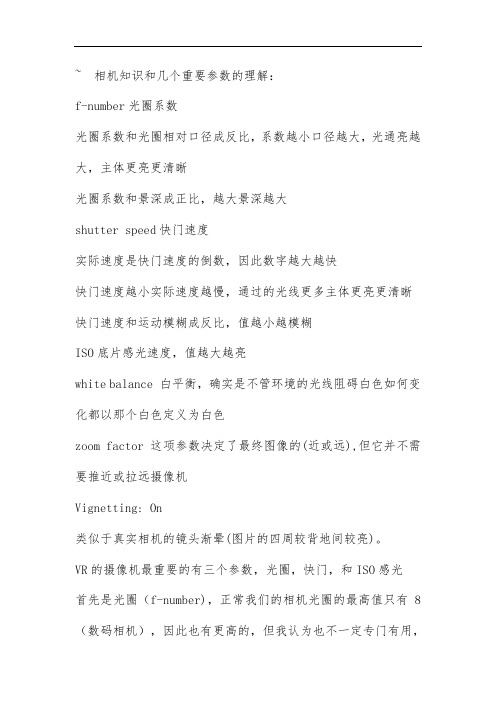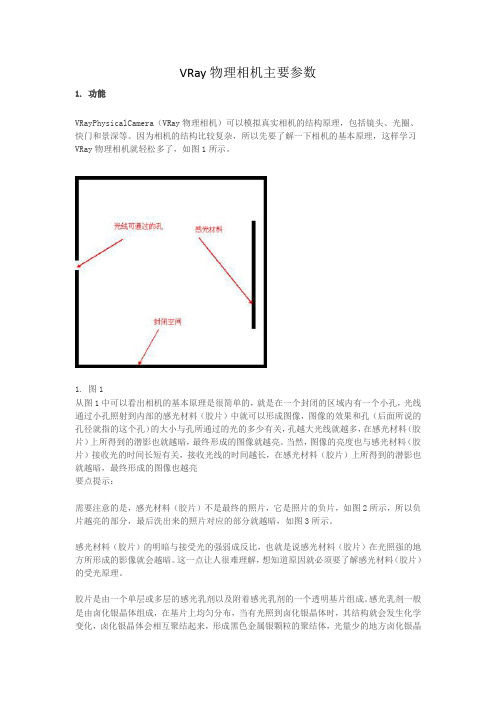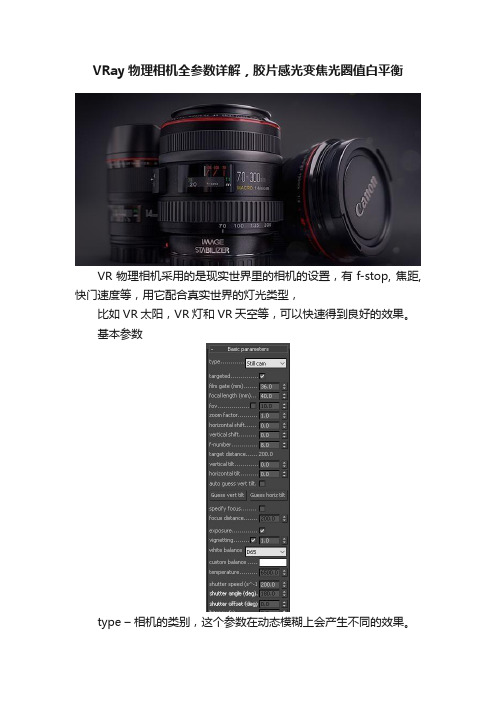VR物理摄像机参数详解
VR-物理相机常规设置参数

1)运行3ds max 2011,打开素材文件“巧克力豆.max”,该文件已经对材质、光源进行了设置,并创建了VR-物理相机,在本训练中,将为大家讲解VR-物理相机的基本编辑参数。
(2)渲染“VR-物理相机001”视图,观察当前场景效果。
(3)选择“VR-物理相机001”,进入“修改”面板。
(4)由于本实例为静态场景,所以在“类型”下拉式选项栏选择“照相机”选项。
提示:“类型”下拉式选项栏内的“摄影机”主要模拟电影相机效果;“摄像机”主要模拟录像机的镜头。
(5)设置“片门大小”参数为60,观察镜头效果。
(6)35mm的胶片是最流行的胶片尺寸,设置“片门大小”参数为35,观察镜头效果。
(7)设置“焦距”参数为100,渲染“VR-物理相机001”视图,观察当前场景效果。
(8)设置“焦距”参数为35,渲染“VR-物理相机001”视图,观察当前场景效果。
(9)设置“缩放因数”参数为3,观察镜头效果。
(10)设置“缩放因数”参数为1,观察镜头效果。
(11)设置“水平偏移”参数为0.4,观察镜头效果。
(12)设置“水平偏移”参数为0,观察镜头效果。
(13)设置“垂直偏移”参数为0.3,观察镜头效果。
(14)设置“垂直偏移”参数为0,观察镜头效果。
(15)设置“光圈系数”参数为1,渲染“VR-物理相机001”视图,观察当前场景效果。
(16)设置“光圈系数”参数为7,渲染“VR-物理相机001”视图,观察当前场景效果。
(17)设置“垂直纠正”参数为1,观察镜头效果。
(18)设置“垂直纠正”参数为0,观察镜头效果。
(19)设置“水平纠正”参数为1,观察镜头效果。
(20)设置“水平纠正”参数为0,观察镜头效果。
(21)设置“渐晕”参数为5,渲染“VR-物理相机001”视图,观察当前场景效果。
提示:选择“渐晕”复选框后,可以模拟真实相机的虚光效果,也就是画面中心部分比边缘部分的光线亮。
(22)设置“渐晕”参数为1,渲染“VR-物理相机001”视图,观察当前场景效果。
VR物理相机功能全分析培训文件

~ 相机知识和几个重要参数的理解:f-number光圈系数光圈系数和光圈相对口径成反比,系数越小口径越大,光通亮越大,主体更亮更清晰光圈系数和景深成正比,越大景深越大shutter speed快门速度实际速度是快门速度的倒数,因此数字越大越快快门速度越小实际速度越慢,通过的光线更多主体更亮更清晰快门速度和运动模糊成反比,值越小越模糊ISO底片感光速度,值越大越亮white balance 白平衡,确实是不管环境的光线阻碍白色如何变化都以那个白色定义为白色zoom factor这项参数决定了最终图像的(近或远),但它并不需要推近或拉远摄像机Vignetting: On类似于真实相机的镜头渐晕(图片的四周较背地间较亮)。
VR的摄像机最重要的有三个参数,光圈,快门,和ISO感光首先是光圈(f-number),正常我们的相机光圈的最高值只有8(数码相机),因此也有更高的,但我认为也不一定专门有用,因此我的光圈数值一般都操纵在 8以内,现实的相机光圈还有一个作用确实是操纵景深,值越低所拍物体焦点的四周就更模糊,数值越高四周就更清晰。
除非你开了景深,要不一般都操纵在5-8那个范围内,数值越低就越亮,数值越高就越暗第二是ISO感光(film speed iso)也能够讲胶片的速度,依照摄像的经验,白天ISO都操纵在100-200,晚上操纵在300-400 那么现在这二个值大致都明确如何去设置了,接下来确实是快门了第三快门shutter speed(s^-1)快门越低暴光的时刻就越长,也越亮,快门越高暴光时刻越短,也越暗,因此,假如你的场景有500平方,又只有一只萤火虫照明,你开到最低-1也见不得会亮起来,也必须把光圈的值降低才能够现在明白摄像机的好处了吧,假如我所讲的那个场景,MAX相机是不可能实现照明,但VR的物理相机能够,也确实是当你把参数设好后,假如觉得整体太亮或太暗就不用动灯光了,只要动摄像机就行了VR物理相机3Ds max2009-08-18 18:25 阅读367 评论0字号:大中小vray 物理相机(2009-07-25 07:29:39)标签:杂谈VRay物理相机差不多原理详解2009/03/15 18:411. 功能VRayPhysicalCamera(VRay物理相机)能够模拟真实相机的结构原理,包括镜头、光圈、快门和景深等。
Vray物理相机介绍主要参数

VRay物理相机主要参数1. 功能VRayPhysicalCamera(VRay物理相机)可以模拟真实相机的结构原理,包括镜头、光圈、快门和景深等。
因为相机的结构比较复杂,所以先要了解一下相机的基本原理,这样学习VRay物理相机就轻松多了,如图1所示。
1. 图1从图1中可以看出相机的基本原理是很简单的,就是在一个封闭的区域内有一个小孔,光线通过小孔照射到内部的感光材料(胶片)中就可以形成图像,图像的效果和孔(后面所说的孔径就指的这个孔)的大小与孔所通过的光的多少有关,孔越大光线就越多,在感光材料(胶片)上所得到的潜影也就越暗,最终形成的图像就越亮。
当然,图像的亮度也与感光材料(胶片)接收光的时间长短有关,接收光线的时间越长,在感光材料(胶片)上所得到的潜影也就越暗,最终形成的图像也越亮要点提示:需要注意的是,感光材料(胶片)不是最终的照片,它是照片的负片,如图2所示,所以负片越亮的部分,最后洗出来的照片对应的部分就越暗,如图3所示。
感光材料(胶片)的明暗与接受光的强弱成反比,也就是说感光材料(胶片)在光照强的地方所形成的影像就会越暗。
这一点让人很难理解,想知道原因就必须要了解感光材料(胶片)的受光原理。
胶片是由一个单层或多层的感光乳剂以及附着感光乳剂的一个透明基片组成。
感光乳剂一般是由卤化银晶体组成,在基片上均匀分布,当有光照到卤化银晶体时,其结构就会发生化学变化,卤化银晶体会相互聚结起来,形成黑色金属银颗粒的聚结体,光量少的地方卤化银晶体会相互聚结也少,这样就形成了影像(负像)。
负像上黑暗(厚的)部分就是曝光较多部分;明亮(薄的)部分就是曝光较少的部分;全透明部分就是没有受到光照射的部分。
上面的理论有些复杂,其实这些理论的最终解释就是相机上的孔径大小以及光通过孔的时间与最后洗出来的照片的明暗区是成正比的。
2. 图23. 图3真实相机的结构要比图1中复杂,如图4所示,最主要的就是增加了镜头、光圈、快门和焦距控制等装置。
VRay物理相机全参数详解,胶片感光变焦光圈值白平衡

VRay物理相机全参数详解,胶片感光变焦光圈值白平衡VR物理相机采用的是现实世界里的相机的设置,有f-stop, 焦距, 快门速度等,用它配合真实世界的灯光类型,比如VR太阳,VR灯和VR天空等,可以快速得到良好的效果。
基本参数type –相机的类别,这个参数在动态模糊上会产生不同的效果。
Still cam –模拟普通相机在常规快门速度下的效果。
Cinematic camera –模拟带有圆形快门的影视摄影机效果。
Video camera –模拟带有CCD矩阵的摄影机效果。
targeted –决定在场景里是否看到相机的目标点film gate (mm) –以毫米为单位,定义片门的水平数值。
垂直数值则由渲染图的比例进行相应的缩放(垂直胶片尺寸 = 水平胶片尺寸 / 宽高比).focal length (mm) 焦距–决定了相机的焦距。
fov –当勾选时,这个参数的数值会取代之前的film gate和focal length两项参数。
zoom factor (变焦)–模拟相机的变焦效果。
数值高于1,相当于放大效果,小于1,相当于缩小效果。
horizontal shift –调整相机的水平视界,比如0.5的数值,会让相机向左侧移动当前画面水平宽度的一半。
vertical shift –调整相机的垂直视界,比如0.5的数值,会让相机向上方移动当前画面垂直高度的一半。
f-number(光圈值)–决定了相机的光圈。
如果Exposure(曝光)选项被勾选的话,更改这个参数还会对画面的亮度产生影响。
target distance –定义了相机与目标点之间的距离。
vertical tilt和horizontal tilt –模拟偏斜镜头的效果。
点击Guess vert tilt和Guess horiz tilt按钮对画面进行两点透视的修正(保持透视的垂直和水平)。
auto guess vert. –当勾选时,相机在动画时也会自动修正偏斜。
VR常用参数详解

V-Ray常用参数详解一、帧缓冲器解析:1、启用内置帧缓冲器。
勾选将利用VR衬着器内置的内置帧缓冲器,VR衬着器不会衬着任何数据到max本身的帧缓存窗口,而且削减占用系统内存。
不勾选就利用max本身的帧帧缓冲器。
2、显示上一次VFB:显示上次衬着的VFB窗口,点击按钮就会显示上次衬着的VFB窗口。
3、衬着到内存帧缓冲器。
勾选的时候将成立VR的帧缓存,并利用它来存储色彩数据以便在衬着时或衬着后察看。
假如需要衬着高分辨率的图象时,建议利用衬着到V-Ray图象文件,以节流内存4、从MAX获得分辨率:勾选时VR将利用设置的3ds max的分辨率。
5、衬着到V-Ray图象文件:衬着到VR图象文件。
近似于3ds max的衬着图象输出。
不会在内存中保存任何数据。
为了察看系统是如何衬着的,你可以勾选后面的出产预览选项。
6、保留伶仃的衬着通道:勾选选项许可在缓存中指定的特别通道作为一个伶仃的文件保留在指定的目录。
二、全局设置解析:1、几何体:置换:决定是不是利用VR置换贴图。
此选项不会影响3ds max本身的置换贴图。
2、照明:灯光:开启VR场景中的直接灯光,不包括max场景的默许灯光。
假如不勾选的话,系统主动利用处景默许灯光衬着场景。
默许灯光:指的是max的默许灯光。
埋没灯光。
勾选时埋没的灯光也会被衬着。
暗影:灯光是不是发生暗影。
仅显示全局光。
勾选时直接光照不参与在终究的图象衬着。
GI在计算全局光的时候直接光照也会参与,可是最后只显示间接光照。
3、材质反射/折射:是不是考虑计算VR贴图或材质中的光线的反射/折射效果,勾选。
最大深度:用于用户设置VR贴图或材质中反射/折射的最大反弹次数。
不勾选时,反射/折射的最大反弹次数利用材质/贴图的局部参数来控制。
当勾选的时候,所有的局部参数设置将会被它所代替。
贴图:是不是利用纹理贴图。
过滤贴图:是不是利用纹理贴图过滤。
勾选时,VR用本身抗锯齿对纹理进行过滤。
最大透明级别:控制透明物体被光线追踪的最大深度。
VRAY-14-1摄影机

VRAY-14-1摄影机在VRay渲染器中用户通过物理摄像机课以模拟出真实的摄像机效果,其参数面板如图1-28所示。
图1-28 VRayPhysicalCamera的参数面板下面对每一个参数进行详细介绍,并配合上测试图使读者更加清晰的理解每一个参数的意义1. Basic parameters(1)type(类型):VRay的物理摄像机内置了三种类型的摄像机,用户可以切换不同的摄像机类型。
①Still camera(静态摄像机):主要模拟最常规的静态画面的摄像机,也是在建筑表现中最常用的一种摄像机类型。
②Cinematic camera(电影摄像机):主要用来模拟电影摄像机效果。
③Video camera(视频摄像机):用来模拟快门摄像机,就是模拟录像机的镜头。
(2)Targeted(目标):勾选此选项,摄像机的目标点将放在焦平面上;勾选Target distance 后,可以手动调节目标点的位置。
(3)Film gate(mm)(片门大小):控制摄像机所看到的范围,值越小,看到的景越少。
(4)Focal length(mm)(焦长(单位MM)):设置摄像机的焦距。
(5)Zoom factor(放大系数):调节摄摄像机视图的缩放。
值越小,摄像机视图拉得越远。
(6)Distortion(扭曲):调节摄摄像机的扭曲系数。
扭曲效果是由下面的distortion type (扭曲类型)来控制的。
(7)Distortion type:扭曲类型,包括quadratic平方cubic立方两种模式。
可以调节对镜头的扭曲。
(8)f-number(光圈系数):设置摄像机光圈的大小。
通过调节光圈系数可以控制图像的亮度,值越大图越暗,值越小图越亮。
之前讲过它和景深也有关系,光圈大的时候景深小,光圈小的时候景深大。
如图1-29、图1-30和图1-31所示为不同f-number数值的渲染效果对比。
图1-29 f-number为2的渲染效果图1-30 f-number为3.5的渲染效果图1-31 f-number为6的渲染效果(9)Target distance(目标点距离):调节目标点距离,只有在targeted未勾选时才有效。
vr物理相机的参数详解(Thep...

vr物理相机的参数详解(The parameters of vr physical camera aredetailed)VR physics camera parameter translation (2009-07-28 19:54:04) reprint label: photography, VR, aperture, shutter, check, Vray, physics, camera homeCompared to cameras with Max itself, the VR physics camera simulates true imaging and allows easier adjustment of perspective. Cameras alone can control exposure, and there are many other very good features and effects.Since I know very little about photography, I read a few articles online to find out its parameters.Basic parameters: basic parametersType: typeStill cam cameraMovie cam cameraVideo cameraTargeted target pointFilm gate (mm) gate sizeFocal, length (mm) focal lengthZoom factor amplification factorF-number aperture factorTarget distance destination distance (valid when targeted is not checked)Distortion twistDistortion type twist typeQuadratic squareCubic cubeVertical shift vertical correctionGuess vertical shift automatic vertical correctionSpecify focus manual focusFocus distance focal length (valid when specify focus is checked)Exposure exposureVignetting vignettingWhite balance white balanceShutter speed (1/x) shutter (camera)Shutter angle (DEG) shutter angle (camera)Shutter offset (DEG) shutter offset (camera)Latency (s) delay (camera)Film speed (ISO) film speedBokeh effiects: special effectsBlades aperture blade countRotation (DEG) rotationCenter bias center offsetAnisotropy anisotropySampling samplingDepth-of-field depth of fieldMotion blur motion blurSubdivs subdivisionCamera knowledge and understanding of several important parameters:F-number aperture factorThe aperture coefficient is inversely proportional to the aperture relative to the aperture. The smaller the coefficient, the greater the aperture, and the greater the luminous intensity, the brighter and clearer the bodyThe aperture coefficient is proportional to the depth of field, and the greater the depth of fieldShutter speed shutter speedThe actual speed is the reciprocal of the shutter speed, so the larger the number the more quicklyThe smaller the shutter speed, the slower the actual speed. The more light passed through, the brighter and clearer the subjectThe shutter speed is inversely proportional to the motion blur, and the smaller the value, the more blurred the motionISO film speed, the greater the value of lightThe white balance white balance is defined as white, regardless of how light affects the white color of the environmentZoom factor this parameter determines the final image (near or far), but it does not need to push near or pull the camera awayVignetting: OnSimilar to the actual camera lens vignetting (pictures aroundthe dark, the middle of the bright).VR cameras are the most important of three parameters, aperture, shutter, and ISO sensitiveThe first is the aperture (f-number), the highest value of our normal camera aperture is only 8 (digital camera), there are more, but I think is not very practical, so the numerical aperture is generally controlled within 8, the reality of the camera aperture and a function is to control the depth of field value around the lower shoot objects focus more fuzzy, with higher values around more clearly. Unless you open the depth of field, or generally controlled in the range 5-8, the lower the number the higher the more dark light, numericalSecond is ISO (film speed ISO), also can say film speed, according to the experience of photography, daytime ISO control in 100-200, at night control inWell, now the two values are roughly defined, how to set, and then the shutterShutter speed (s^-1) third shutter shutter of the lower exposure time longer, more bright, more high shutter exposure time is shorter, more dark, of course, if your scene is 500 square, and only a firefly lighting, you also can not see to the lowest -1 will light up, must also the aperture value can be reducedNow I know the benefits of the camera, if I say this scene,MAX cameras are impossible to achieve lighting, but the VR physical camera can, that is, when you set the parameters, if you feel the whole is too bright or too dark, do not have to move the lights, just move the camera on itVR physical cameraPublished at 11:17 2007-01-14, author: Zhou ZhengpingCommon sense in photography (VRAY basic knowledge of camera Physics)1. Film speed (ISO) film sensitivityISO (abbreviated as International Standards Organization).ISO photographic value is the sensitivity of traditional camera negative to light response. The measured value is usually expressed in ISO digitalThe more sensitive, the commonly used methods of expression are ISO 100, 400, 1000 and so on. Generally speaking, the higher the sensitivity, the negative of the filmThe thicker the particle, the less effective the magnification is, and the digital camera also applies this ISO value to mark the exposure used by the metering system, the benchmarkThe lower the ISO, the higher the amount of exposure required.2. aperture (aperture)There is a set of overlapping metal plating in the camera lens. When the exposure time is constant, the aperture will be larger, then the exposure of the film will be enoughThe greater. Represented by the f/ value (f-number). The general camera's diaphragm values are f/1.4, f/2, f/2.8, f/4, f/5.6F/8, f/11, f/16, f/22, the aperture value jumps up and down a grid, and the exposure will be doubled or halved.3. shutter (Shutter)Of course, mainly refers to the shutter speed (Shutter speed). As mentioned above, the opening time of metal leaves is determined.The shutter speed of many cameras is now controlled by the camera's own computer. In the traditional camera or some semi professional, to the higher level cameraThe shutter speed of the camera still needs to be manually operated, mainly including the following, from slow and fast, 1, 1/2, 1/4, 1/8, 1/15, 1/30,1/60, 1/125, 1/250, 1/500, 1/1000 seconds, and in some of the more professional cameras, there are longer or shorter than theseGate speed setting. In the same way, the shutter speed jumpsup and down at one or more times, and the amount of exposure is doubled or halved.4. the relationship between the aperture and the shutterThe larger the aperture, the shorter the relative exposure time (under special conditions), and there are many different shutter speedsYou can get the same exposure with the aperture and the aperture, but the exposure may not be the same, because it involves the depth of fieldLater on. The lens with the largest aperture is called a fast lens because it matches the shutter speed at a relatively fast pace.5. depth of field (Depth-of-field)Sometimes you can see some pictures of the subject and background are very clear, but also seen only the main clear, and around the focus of the photos Lost focus.To produce these effects involves the problem of depth of field. When selecting the faster exposure rate, we usually need to use the ratioThe larger the aperture, then the depth of field will be relatively short, the clear range of the picture will be relatively small, some scenes may be more obscure; andIf the shutter speed is slow, so the aperture can be small, then there may make the picture dictation messy you don't part ofCome out now. Therefore, how to control the depth of field is an initial and important technique in photography.conceptSimply put, depth of field is the clear range of the scene of the photograph. Theoretically, only objects in the focus plane are clear, but due toThe discrimination of the naked eye, so in general, some objects around the focal plane will behave very clearly.Factors related to depth of fieldThe focal length of the 1. lensThe focal length of the lens is different, and the depth of field will vary. A long lens produces a shorter depth of field, and a short shot produces a ratioLonger depth of field effect.2. irisIn general, the larger the aperture, the shorter the depth of field, and the smaller the aperture, the longer the depth of field.The distance between the 3. shots from the main bodyThe closer the body is, the shorter the depth of field is. Vice versa。
vr物理相机的参数详解

VR物理相机
发表于 2007-01-14 11:17 作者: 周正平
摄影常识(VRAY物理相机最基本常识)
头,广角镜头,超望远镜头,微距镜头,变焦镜头等等,不过对于现在大多数普通的数码相机用
户来说,由于镜头不可更换,而且由于价钱太昂贵,所以备一堆镜头的可能不大,大家作为基础
了解了解吧。
对于长镜头和短镜头之间的主要差别,其实就在于视角的不同(也就是所能包括入画面的范围的
不同)。例如15mm的超广角镜头的视角为110度,而600mm的超望远镜头的视角只有4度。另外
长焦镜头又叫望远镜头,望远镜头拍出来的影像比短焦镜头更大。
短焦镜头又叫广角镜,广角镜因焦距非常短,所以投射到底片上的景物就变小了。事实上,各种
镜头最大的差别是焦距不同。焦距基本上决定了影像的大小。
焦距大小与视角大小成反比。焦距越大,视角越小;焦距越小,视角越大。
短焦距称为广角镜,视角大,它的特性是强调近景,压缩远景,透视感很好,使用时对焦容易。
exposure暴光
vignetting渐晕
white balance白平衡
shutter speed(1/x)快门(照相机)
shutter angle(deg)快门角度(摄影机)
shutter offset(deg)快门偏移(摄影机)
latency(s)延迟(摄像机)
film speed(ISO)底片感光速度
VR物理相机的参数翻译(2009-07-28 19:54:04)转载标签:摄影vr光圈快门勾选vray物理相机家居
- 1、下载文档前请自行甄别文档内容的完整性,平台不提供额外的编辑、内容补充、找答案等附加服务。
- 2、"仅部分预览"的文档,不可在线预览部分如存在完整性等问题,可反馈申请退款(可完整预览的文档不适用该条件!)。
- 3、如文档侵犯您的权益,请联系客服反馈,我们会尽快为您处理(人工客服工作时间:9:00-18:30)。
VR物理摄像机参数详解
vr物理摄像机和max本身带的摄像机相比,它能模拟真实成像、能更轻松的调节透视关系。
单靠摄像机就能控制暴光,另外还有许多非常不错的其他特殊功能和效果。
由于我对摄影了解甚少,先在网上看了几篇文章,了解一下它的参数。
Basic parameters :基本参数
type:类型
still cam照摄像机
movie cam摄影机
video摄像机
targeted目标点
film gate(mm)片门大小
focal length(mm)焦距
zoom factor放大系数
f-number光圈系数
target distance目标点距离(但targeted未勾选时有效)
distortion扭曲
distortion type扭曲类型
quadratic平方
cubic立方
vertical shift 垂直纠正
guess vertical shift 自动垂直纠正
specify focus手动调焦
focus distance焦距(当specify focus勾选时有效)
exposure暴光
vignetting渐晕
white balance白平衡
shutter speed(1/x)快门(照摄像机)
shutter angle(deg)快门角度(摄影机)
shutter offset(deg)快门偏移(摄影机)
latency(s)延迟(摄像机)
film speed(ISO)底片感光速度
Bokeh effiects:散景特效
blades光圈刃片数
rotation(deg)旋转
center bias中心偏移
anisotropy各向异性
sampling采样
depth-of-field景深
motion blur 运动模糊
subdivs细分
PS:双击获取文档,ctrl+A,ctrl+C,然后粘贴到word即可。
未能直接提供word版本,抱歉。
